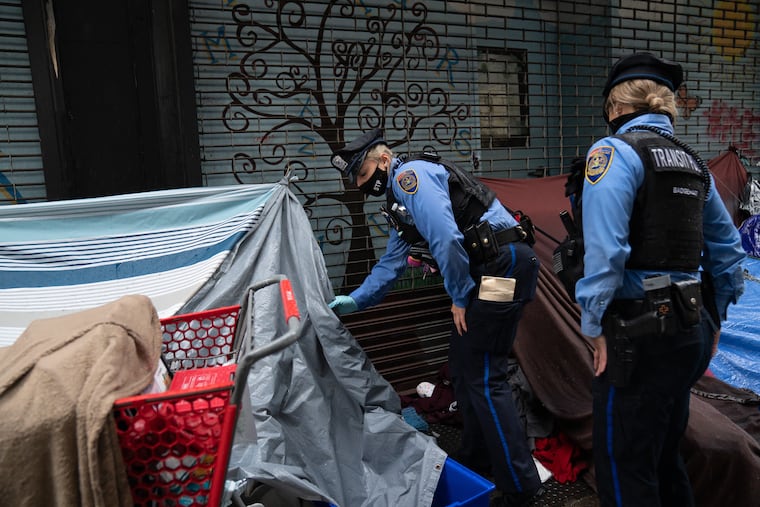Philly City Council members announce new police station, other initiatives in Kensington
Two shelters for homeless people in addiction run by the public health organization Prevention Point will move off Kensington Avenue and onto the campus of Temple University’s Episcopal Hospital.

Philadelphia lawmakers on Tuesday announced a cluster of new initiatives billed as improving quality of life for the residents of Kensington, the neighborhood hardest hit by the city’s opioid crisis. Among them are a new mini-police station in the heart of the area’s drug trade and moving some services for people in addiction to a less visible part of the community.
Two shelters for homeless people in addiction run by the public health organization Prevention Point will move off the Kensington Avenue business corridor and onto the campus of Temple University’s Episcopal Hospital, several blocks away on Lehigh Avenue, by summer.
“In the spirit of being a good neighbor to the community we have been working with the City Council folks to ensure we transition some of the services that we have located on the avenue,” said Jose Benitez, Prevention Point’s executive director. He said it would be easier to have the shelter services consolidated in one location.
In addition, Prevention Point will distribute more clean syringes elsewhere in the city, reducing the number handed out in Kensington by two million by the end of the year, Benitez said. City officials said that they wanted to distribute syringes more “equitably” around the city, noting that some areas of the city are underserved.
People in addiction in Kensington will still be able to get the clean syringes they need to reduce the spread of HIV and other infections related to drug use, he said.
City officials, including Councilmembers Maria Quiñones-Sánchez and Mark Squilla, whose districts both encompass parts of the neighborhood, said Kensington had long borne the brunt of a widespread opioid crisis, and that they want to improve the quality of life in the neighborhood.
The plan is similar in some respects to an earlier city-led initiative called the Resilience Project, which declared a disaster in Kensington because of the opioid crisis, and focused on residential quality-of-life issues as well as preventing overdoses.
City officials said the health department is working on a separate plan to combat rising overdoses. Philadelphia was on track for a record-high number of overdoses in 2020, likely exacerbated by the COVID-19 pandemic shutdowns, and increasingly affecting Black and Latino residents.
Other initiatives largely geared toward permanent residents include repairing houses in the neighborhood, more regular trash clearing, affordable-housing construction, and better lighting along the avenue and Market-Frankford subway tracks.
“No neighborhood in the city of Philadelphia should be a containment neighborhood [for the drug trade], and Kensington will not continue to be a containment neighborhood,” Quiñones-Sánchez said.
Philadelphia Police Commissioner Danielle Outlaw said the mini police station will focus solely on patrolling the Kensington Avenue Corridor and streets surrounding McPherson Square, which has been overwhelmed by drug dealing and gun violence.
The area of focus includes the heart of Kensington’s booming heroin and fentanyl trade, long considered among the largest open-air drug markets in the nation, law enforcement officials say.
The police districts that cover Kensington have long been some of the deadliest in the city. From 2012 to 2017, the 25th District, which covers parts of Kensington and North Philadelphia, had more homicides, shooting victims, and recovered firearms than any other district in the city. Last year, the 24th District, which covers parts of Fairhill and Harrowgate, had the most shootings and homicides in the city, and homicides and nonfatal shootings both doubled, from 130 nonfatal shootings to 277, and from 27 homicides to 60.
Similar to substations in Center City and on South Street, the new district will have its own command structure and several dozen officers to serve businesses and residents between Somerset Street and Allegheny Avenue and from D Street to Frankford Avenue.
Outlaw said that just having a “very visible presence” will be key. “More of a personalized feel given that they are assigned solely to a smaller part of the area,” she said.
Police already regularly deploy bike officers and foot patrols along Kensington Avenue and McPherson Square.
The new targeted resources will allow other police commanders to focus on crime throughout the rest of the district, Outlaw said. Deputy Police Commissioner Joel Dales, who oversees patrol, said the department has also added more narcotics officers to the neighborhood, who will focus on high-level leaders of drug-trafficking operations.
Staff writer Mike Newall contributed to this report.